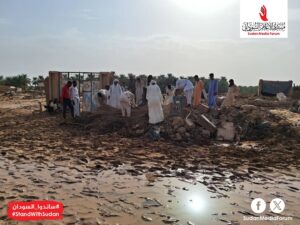Floods ravage Northern Sudan State, leaving thousands homeless and desperate
This report by Sudan Tribune is published as part of a collaborative newsroom initiative by the Sudan Media Forum.
August 25, 2027 (ABU HAMAD, Northern State) – Two weeks after record rainfall and floods devastated Northern Sudan, tens of thousands of residents remain homeless, with no aid from the federal government or humanitarian organizations. The situation is particularly dire in Abu Hamad, where an estimated 65,000 people have been affected and only 210 tents are available.
“The war drove us out of Khartoum, and now the flood has driven us out of the house that sheltered us in Abu Hamad,” said Mohassen Khadr, a 60-year woman displaced from Omdurman, who lost her home in the floods.
Residents in the states of River Nile and Northern, in the far north of Sudan, were accustomed to the destructive Nile floods in the past, but the recent rainfall was unprecedented. The city of Abu Hamad, located about 540 kilometres north of the Sudanese capital, Khartoum, and the surrounding islands were subjected to record rainfall on the night of August 5th. The rainfall reached 142 mm, accompanied by torrential floods that caused significant damage for the first time to the railway line, built about 120 years ago, and the city’s old market.
The damage to the city’s neighbourhoods, especially the Al-Qoz neighbourhood, was severe. The disaster was clearly evident on Muqarrar Island, particularly in the village of Abu Sidir, which was completely swept away by the flood, resulting in three deaths.
“The flood we experienced was unprecedented in the region,” said one resident of Abu Sidir. “An ancient fortress near the Nile bank from the Christian era was swept away by the flood, something that had never happened before.”
Villagers recount harrowing stories of the night the floods hit, where they clung to trees, fearing being swept away into the river, as their mud-brick houses could not withstand the flood.
The plight of those affected in the Abu Hamad locality centres on the lack of any aid. Despite the fact that the Chairman of the Sovereign Council, Abdel Fattah al-Burhan, visited the area and inspected the damage, no tents have arrived to shelter displaced families.
“The rains and floods affected about 13,000 families,” said Youssif Habib, the Director of Social Welfare in Abu Hamad locality. “The locality only has 210 tents.”
The official added that the authorities chose not to distribute these tents due to the significant shortage and are awaiting the arrival of aid to provide shelter.
He pointed out that the popular effort filled the food shortage, but the need now is for tents, especially with expectations of continued rain.
 According to the local authorities in Abu Hamad, the rains and floods caused the deaths of 35 people in the locality.
According to the local authorities in Abu Hamad, the rains and floods caused the deaths of 35 people in the locality.
Residents in the city of Abu Hamad and the affected islands are increasingly concerned about the environmental and health consequences of the rains and floods, in light of the spread of mining activities and the slow pace of disease vector spraying and water suction operations.
It is worth noting that Abu Hamad locality benefits from the revenue of fees imposed on extensive mining activities in the region, as it houses the largest mining markets in Sudan, with about a million people working in mining and related activities.
Floods and torrential rains displacing thousands
Under the cover of night on August 10th, the town of Tanqasi was engulfed by a devastating flood. Residents awoke to a deluge of water, described as a biblical torrent, pouring from the sky and surging from the ground.
The flood claimed the lives of nine people, mostly children, including four from a single family. Mahjoub Mohamed Sid Ahmed, the Executive Director of the Merowe locality, confirmed the destruction of over 700 homes, with hundreds more partially damaged.
“We need tents before we start building a house again,” pleaded Haj Suleiman, a 70-year-old resident whose home was destroyed in both the 1988 Nile flood and this recent disaster. The locality is grappling with a severe shortage of tents, shelter materials, and antivenin for scorpions and snakes.
The Ministry of Health in the Northern State reported a grim toll: 31 deaths, 179 injuries, and 155 cases of scorpion stings across the state. Over 2,350 houses and 31 government facilities were completely destroyed, leaving 6,500 families severely affected.
Beyond Northern State
The devastation extends far beyond Tanqasi. In West Darfur, the state capital, El Geneina, was declared a disaster area after floods destroyed 7,000 homes. Heavy rains caused unprecedented flooding of Wadi Kaja, leading to the collapse of the Morni bridge, a vital link between El Geneina and Zalingei. Reports indicate travellers drowned while attempting to cross the flooded valley.
In North Darfur, camps for displaced people in El Fasher suffered losses due to heavy rains. In eastern Sudan, three people died in the Red Sea state due to rains and winds. Floodwaters inundated three camps for displaced people in Kassala state, also resulting in two deaths.
The rains and floods have compounded the suffering of Sudanese people already grappling with the ongoing war and food shortages. The Interior Minister announced the loss of 198,000 acres of agricultural land and numerous livestock.
The United Nations Office for the Coordination of Humanitarian Affairs (OCHA) warned in July of above-average rainfall, exacerbating the plight of millions of displaced people.
As Sudan faces this dual crisis of conflict and natural disaster, the resilience of its people is being tested to the limit. The urgent need for humanitarian aid and long-term solutions to address both the war and the impacts of climate change is more pressing than ever.

